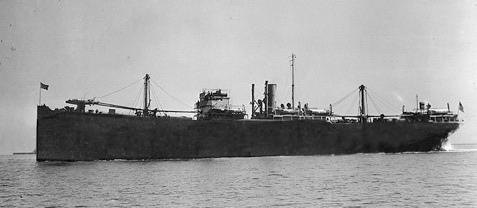Andalusia

Andalusia
Originally named the USS Volunteer (ID #3242), the 7,955 ton collier
ship was built in Alameda, California, in 1918 (launched on May 18,
-
1918)and was taken over by the Navy on August 23rd of that same year.

The Volunteer was built by the Bethlehem Shipbuilding Corp. for the
United States Shipping Board, Lt. Commander. John G. Moreno, USNRF, in
command. She measured 410 feet long, with a beam of 56 feet, draft 30
feet 6 inches, she displaced 16,100 tons, and she could top out at
10.5 knots.
The Volunteer set sail from San Francisco on September 7th 1918,
bound for the Far East. During that voyage, she made port calls at
Shanghai and Hong Kong before arriving at Manila on October 24th. From
there, she moved south to Iloilo on the island of Panay, located in
the central Philippines.
She reached port on November 6th and after a false start and a return
for additional fuel, finally set course back to the United States on
December 8th. The Volunteer reached Oahu on New Year's Day 1919 and
remained in Hawaii until the 9th when she then got underway for the
east coast. The collier ship arrived in New York City on February 15th
1919. Twelve days later, on February 27th, 1919, she was placed out of
commission and was ordered to return to the United States Shipping
Board.
After a short run in service, the USS Volunteer was struck from the
Navy list that same day (Feb. 27th), but remained in the possession of
the US Shipping Board until 1937. At that time she was sold to the

this time the Lykes Bros. began selling its older tonnage and
replacing them with modern C type ships. By the end of 1940, 35 new
ships were delivered to the company; the USS Volunteer, renamed SS
Volunteer, was one of them. The steamship company served as a general agent for the War Shipping Administration during World War II. The
Lykes Bros. operated the vessel under the name SS Volunteer until
1946, when it was sold to the Triton Shipping Company of New York in
1947.
Renamed the Andalusia, Triton (also under Arm. Transatlantica
Panamanian registry) had her delivering various cargos around North
America.
On Friday night November 4th, 1949, while carrying a load of
5,000,000-foot lumber to the Atlantic Coast from Vancouver, a fire
started in the engine room. The Captain George Lemos and his crew had
the fire extinguished in about 1 ½ hours, but the damage had been
done. While trying to fight the fire the large vessel ran aground on a
large pinnacle near Neah Bay.
Saturday morning the Coast Guard attempted to refloat the battered
Andalusia, but the attempts were futile. That same day the Coast Guard
reported she was taking on water and the engine room plates were
heavily damaged. 19 of the crew were offloaded but the Captain and 8
crewmen stayed behind to try and rescue the damaged ship.
The battle continued when on Monday, November 7th, rivets were heard popping from the hull plates. Two attempts were made by salvage tugs to pull her free over the weekend but the battered ship merely shifted
her weight and held her ground.
Tuesday November 8th, seven tugs attempted to pull the Andalusia free of the rocks but quickly decided to halt further attempts until the
lumber was offloaded. Two Canadian tugs were en route to Vancouver BC
to pick up two large barges to transfer the cargo. That same day the
weather threatened to bash the vessel with larger waves and an
impending storm with 50 mph winds, so the Captain and remaining crew
were removed from the dying freighter.
Wednesday November 9th, attempts were ceased to remove the lumber onto two barges. The storm continued to take toll on the stranded
ship.
Thursday November 10th, in the early morning hours the beaten Collier ship breaks up.

Friday November 11th, famous photographs were taken of the mighty
Andalusia broken in half (just forward of the funnel), tugs trying to
salvage the two halves, by beaching them near Bowman Beach.
Attempts at saving the Andalusia finally failed when she gave in to
the sea and sank in two pieces in approximately 60 feet of water. A
portion of cargo was removed before the aft section sank.





-
-Home
